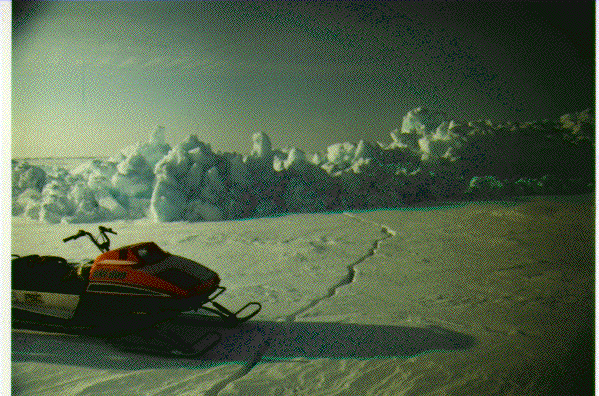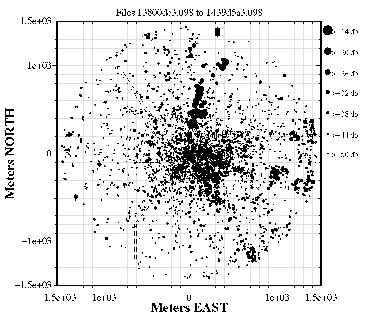
SEA ICE FRACTURE INVERSION
Sea Ice Mechanics Initiative

Principal Investigator
Prof. Henrik Schmidt , MIT Dept. Ocean EngineeringAssociate Investigators
Prof. A.B. Baggeroer, MIT Dept. Ocean EngineeringProf. Ira Dyer, MIT Dept. Ocean Engineering
Prof. J. Robert Fricke
Students
Yuriy DudkoQing Wang
Catharina Stamulis
Tarun Kapoor
Olga Chernets
Collaborating Institutions
Woods Hole Oceanographic InstitutionSponsors
Office of Naval ResearchOBJECTIVES
The several Arctic acoustics experiments of the past have made it clear that ice fracturing is the dominant source of ambient noise, in turn suggesting that fracturing forms a major component of the physical processes leading from environmental forcing to the development of macroscopic ice features such as ridges, leads and raftings. On this background, the specific objective of the MIT/WHOI effort under the Sea-Ice Mechanics ARI is to develop a basic understanding of these ice fracturing processes and their relation to the environmental forcing, covering spatial scales of mm to km, and temporal scales of ms to hours. As a byproduct, the effort is expected to also improve the understanding the interaction between acoustic waves in the water column and seismic waves in the ice. Another component of our 1994 effort was aimed at determining the feasibility of using long range acoustic transmission to infer changes in global climate. Finally, the large amounts of acoustic data collected during the various field experiments is expected to lead to better understanding of the ambient Arctic acoustic environment. Of particular current interest is the marine mammal component. Analysis of our database can provide unique behavioral data to the marine mammal biologists.APPROACH
The current MIT/WHOI effort extends earlier work on acoustic ice fracture inversion, vastly improving the resolution to allow for direct determination of source-plane parameters uniquely defining the fracture processes, such as fracture location, type, orientation, seismic moment and rupture speed, while at the same time maintaning substantial spatial coverage. This is accomplished through a coordinated and consistent effort in experiment design and execution, seismo-acoustic source and propagation modeling, and advanced signal processing. In the Spring 94 SIMI experiment, a large aperture acoustic ``surveillance array'' was used to localize areas of high seismicity through real-time, adaptive array processing. Such active areas were then on several occations instrumented with seismic arrays for monitoring the acoustic emission in the near field, with the data transmitted to base camp using a wireless LAN link. The inversion is performed by seismic matched field processing. The feasibility of using transarctic acoustic propagation (TAP) to infer climate changes is addressed by analyzing the SIMI-94 array data as well. The transmissions from the Russian source deployed NE of Spitzbergen were received on the horizontal and vertical hydrophone arrays, and the 6 days of high-quality transmission data are currently being compared to model predictions. One of the obstacles to using acoustic thermometry of the oceans is the potentially harmful effect on marine mammals. To address this issue, the SIMI-94 data, and data from previous ice camps are being scanned for marine mammals, and where possible, array processing is be used to track the whales, reveiling potential behavioral changes during active source deployments.
Fig. 1. Ice events located by real-time beamforming on SIMI-94 horizontal hydrophone array between 098:23.00Z and 098:23.59Z, including major events associated with existing crack immediately N of new shear ridge.
1994 ACCOMPLISHMENTS
A major accomplishment in 1994 was the succesful execution of the SIMI-94 experiment, in particular the development and implementation of a new layered approach to the detection of acoustic emission from natural and artificial ice fractures. A 64-element ``surveillance array'' was deployed and used for continuous monitoring of the ice seismicity in a 20 km$^2$ area surrounding the camp. Figure 1 reproduces the beamformer display following a major fracture event at the floe boundary N of the array. As a result of this and other real-time localizations, several deployments of high-resolution seismic arrays were performed, measuring the acoustic emission in the near field. In that regard a crucial accomplishment was the development of the socalled RLAM units comprised of five 3-component geophones and a hydrophone connected to a self-contained acquisition system with digital data telemetry to base camp via a wireless local-area network. This system allowed for extremely rapid deployment, with a unit being deployed, the sensors surveyed, and the recording initiated in less than two hours from the time the deployment was decided. On the modeling side we have continued the development of the more complete and accurate seismic source and propagation models needed for the SIMI fracture plane analysis [Schmidt, 1994]. In particular, we have developed a new approach for modeling propagation in range-varying elastic waveguides [Schmidt etal. 1995]. Another significant accomplishment during the SIMI-94 experiment was the succesful reception of the Transarctic Acoustic Propagation (TAP) transmissions. The data were of extremely high quality, allowing for accurate estimation of the modal arrival structure. In parallel we have refined our Arctic modeling capability by combining the ice scattering model developed at MIT [LePage and Schmidt, 1994] with the KRAKEN coupled-mode propagation model. This combined model has been succesfully applied to model the TAP data.1994 APPLICATIONS
The 3-D elastic ice scattering theory developed under this project has been verified by accurately modeling historical propagation and reverberation data [LePage and Schmidt 1994]. It has been combined with the SAFARI/OASES code to provide a unique capability for waveguide reverberation modeling [Schmidt 1994]. This model is being applied to ONR sponsored research by BBN and Alliant Techsystems. The Arctic modal losses predicted by the model are being used in normal-mode codes for the TAP modeling performed by SAIC and MIT. The OASES code with the new 3D seismic source models have been exported to Lawrence Livermore National Laboratory for use in their nuclear treaty verification research. In addition updated versions of OASES has continued to be widely distributed in the ocean acoustic community in 1994.REFERENCES
- H. Schmidt, ``Seismo-acoustics of the Arctic ice cover.'' In L. Bjorno, editor, Underwater Acoustics, European Commission, Luxembourg, 1994.
- H. Schmidt, W. Seong, and J.T. Goh, ``Spectral super-element approach to range-dependent ocean acoustic modeling,'' J. Acoust. Soc. Am., In Press: 1995.
- K. Lepage and H. Schmidt, ``Modeling of low frequency transmission loss in the Central Arctic,'' J. Acoust. Soc. Am. 96(3), 1783--1795, 1994.